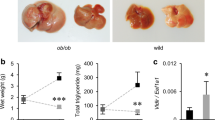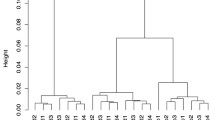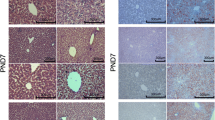Abstract
The present study was addressed to determine whether the high expression of peroxisome proliferator-activated receptor-α (PPAR-α) in rat liver during the perinatal stage plays a role in the induction of liver lipoprotein lipase (LPL) expression and activity. Parallel increases in liver mRNA PPAR-α and LPL activity were found in newborn rats, and after a slight decline, values remained elevated until weaning. Anticipated weaning for 3 days caused a decline in those two variables as well as in the mRNA LPL level, and a similar change was also found in liver triacylglycerol concentration. Force-feeding with Intralipid in 10-day-old rats or animals kept fasted for 5 h showed high mRNA-PPARα and-LPL levels as well as LPL activity with low plasma insulin and high FFA levels, whereas glucose and a combination of glucose and Intralipid produced low mRNA-PPARα and-LPL levels as well as LPL activity. Under these latter conditions, plasma insulin and FFA levels were high in those rats receiving the combination of glucose and Intralipid, whereas plasma FFA levels were low in those force-fed with glucose. It is proposed that the hormonal and nutritional induction of liver PPAR-α expression around birth and its maintained elevated level throughout suckling is responsible for the induction of liver LPL-expression and activity during suckling.
Resumen
Se estudia si la alta expresión del receptor activado por proliferadores peroxisomales-α (PPAR-α) que se observa en el hígado de la rata durante la etapa perinatal, contribuye a la inducción de la expresión y actividad de la lipoproteína lipasa (LPL) que se presenta en este órgano. Se observó un incremento paralelo en el mRNA del PPAR-α y en la actividad LPL del hígado en ratas recién nacidas, y tras un ligero descenso, los valores se mantuvieron elevados hasta el destete. Un destete anticipado de 3 días causó un descenso en esas dos variables y en el nivel de mRNA LPL, así como un cambio semejante en la concentración de triacilgliceroles en el hígado. Animales de 10 días de edad sometidos a alimentación forzada con Intralipid o mantenidos en ayunas durante 5 h mostraron valores altos de mRNA-PPARα y-LPL así como de la actividad de la LPL en hígado, y niveles bajos de insulina y altos de FFA en plasma, mientras que la administración de glucosa o la combinación de glucosa e Intralipid produjeron valores bajos de mRNA-PPARα y-LPL así como de actividad LPL en hígado. Los niveles plasmáticos de insulina y FFA fueron altos en las ratas que recibieron la combinación de glucosa e Intralipid, mientras que los niveles de FFA plasmáticos fueron bajos en los sometidos a alimentación forzada con glucosa. En consecuencia, se propone que la inducción hormonal y nutricional de la expresión del PPAR-α en hígado alrededor del nacimiento y su mantenimiento en valores elevados a lo largo de la lactancia es responsable de la inducción de la expresión y la actividad de la LPL durante esta etapa del desarrollo.
Similar content being viewed by others
References
Black, D., Kirkpatrick, S.A. and Skinner, E. R. (1983):Biochem. Soc. Trans.,11, 708.
Burgaya, F., Peinado-Onsurbe, J., Vilaró, S., Llobera, M. and Ramírez, I. (1989):Biochem. J.,259, 159–166.
Catalano, P. M., Thomas, A., Huston-Presley, L., and Amini, S. B. (2003):Am. J. Obstet. Gynecol.,189, 1698–1704.
Folch, J., Lees, M. and Sloane Stanley, G. H. (1957):J. Biol. Chem.,22, 24–36.
Galán, X., Llobera, M. and Ramírez, I. (1993):Biol. Neonate,64, 295–303.
Giménez-Llort, L., Vilanova, J., Skottova, N., Bengtsson-Olivecrona, G., Llobera, M. and Robert, M. (1991):Am. J. Physiol. (Gastrointest. Liver Physiol., 24),261, G641-G647.
Grinberg, D. R., Ramírez, I., Vilaró, S., Reina, M., Llobera, M. and Herrera, E. (1985):Biochim. Biophys Acta,833, 217–222.
Herrera, E., Lasunción, M. A., Gómez Coronado, D., Aranda, P., López Luna, P. and Maier, I. (1988):Am. J. Obstet. Gynecol.,158, 1575–1583.
Jensen, G. L., Baly, D. L., and Brannon, P. M. (1980):J. Biol. Chem.,255, 11141–11148.
Julve, J., Robert, M. Q., Llobera, M. and Peinado-Onsurbe, J. (1996):Mol. Cell. Endocrinol.,116, 97–104.
Liang, X. F., Ogata, H. Y. and Oku, H. (2002):Comp. Biochem. Physiol. A Mol. Integr. Physiol.,132, 913–919.
Llobera, M., Montes, A. and Herrera, E. (1979):Biochem. Biophys. Res. Commun.,91, 272–277.
Lopez Tejero, D., Llobera, M., and Herrera, E. (1988):Biosci. Rep.,8, 309–314.
Mandard, S., Müller, M. and Kersten, S. (2004):Cell. Mol. Life Sci.,61, 393–416.
Masuno, H., Tsujita, T., Nakanishi, H., Yoshida, A., Fukunishi, R. and Okuda, H. (1984):J. Lipid Res.,25, 419–427.
Olivecrona, T., Bengtsson-Olivecrona, G., Chernick, S. S. and Scow, R. O. (1986):Biochim. Biophys. Acta,876, 243–248.
Panadero, M., Herrera, E. and Bocos, C. (2000):Biochimie,82, 723–726.
Panadero, M., Vidal, H., Herrera, E. and Bocos, C. (2001):Arch. Biochem. Biophys.,394, 182–188.
Paterniti, J. R., Jr., Brown, W. V., Ginsberg, H. N. and Artzt, K. (1983):Science,221, 167–169.
Peinado-Onsurbe, J., Martínez, J.-V., Vilanova, J., Robert, M. Q., Llobera, M. and Ramírez, I. (1990):Biochim. Biophys. Acta,1043, 7–11.
Peinado-Onsurbe, J., Soler, C., Soley, M., Llobera, M. and Ramírez, I. (1992):Biochim. Biophys. Acta,1125, 82–89.
Peinado-Onsurbe, J., Staels, B., Deeb, S., Ramírez, I., Llobera, M. and Auwerx, J. (1992):Biochim. Biophys. Acta,1131, 281–286.
Peterson, J., Olivecrona, T. and Bengtsson-Olivecrona, G. (1985):Biochim. Biophys. Acta,837, 262–270.
Preiss-Landl, K., Zimmermann, R., Hämmerle, G. and Zechner, R. (2002):Curr. Opin: Lipidol.,13, 471–481.
Ramírez, I., Galan, X., Peinado-Onsurbe, J., and Llobera, M. (1998):Fetal and Neonatal Physiology (Polin, R. A. and Fox, W. W., eds.), W.B. Saunder Co., Philadelphia. pp. 535–541.
Ramírez, I., Llobera, M. and Herrera, E. (1983):Metabolism,32, 333–341.
Reina, M., Vilaró, S., Ramírez, I. and Llobera, M. (1987):Biol. Neonate,51, 45–52.
Rovano, L., Taskinen, M.-R., Kuusi, T., Nikkila, E. A., Ehnholm, C. and Raivio, K. O. (1984):Pediatr. Res.,18, 642–647.
Rovano, L. M., Taskinen, M.-R., Kuusi, T., and Raivio, K. O. (1986):Pediatr. Res.,20, 623–627.
Ruiz, J. I. and Ochoa, B. (1997):J. Lipid Res.,38, 1482–1489.
Sabugal, R., Robert, M. Q., Julve, J., Auwerx, J., Llobera, M. and Peinado-Onsurbe, J. (1996):Biochem. J.,318, 597–602.
Schoonjans, K., Peinado-Onsurbe, J., Lefebvre, A. M., Heyman, R. A., Briggs, M., Deeb, S., Staels, B. and Auwerx, J. (1996):EMBO J.,15, 5336–5348.
Semenkovich, C. F., Chen, S.-H., Wims, M., Luo, C.-C., Li, W.-H. and Chan, L. (1989):J. Lipid Res.,30, 423–431.
Staels, B. and Auwerx, J. (1992):Development,115, 1035–1043.
Stein, Y. and Stein, O. (2003):Atherosclerosis,170, 1–9.
Vilaró, S., Llobera, M., Bengtsson-Olivecrona, G. and Olivecrona, T. (1988):Biochem. J.,249, 549–556.
Vilaró, S., Reina, M., Ramírez, I. and Llobera, M. (1986):Biochem. J.,236, 273–278.
Vilaró, S., Testar, X., Ramirez, I. and Llobera, M. (1990):Biol. Neonate,57, 37–45.
Author information
Authors and Affiliations
Corresponding author
Rights and permissions
About this article
Cite this article
Panadero, M., Bocos, C. & Herrera, E. Relationship between lipoprotein lipase and peroxisome proliferator-activated receptor-α expression in rat liver during development. J. Physiol. Biochem. 62, 189–198 (2006). https://doi.org/10.1007/BF03168468
Received:
Issue Date:
DOI: https://doi.org/10.1007/BF03168468




